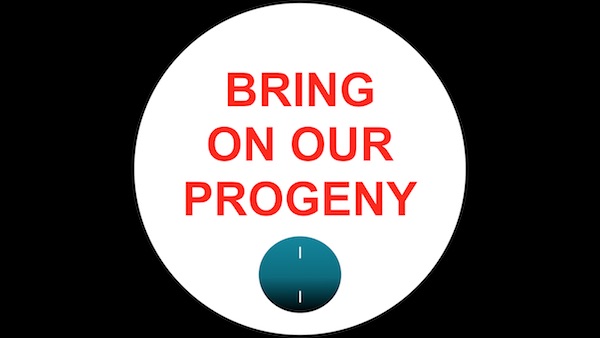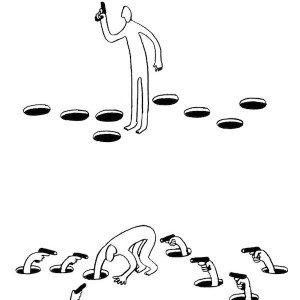Aihwa Ong, interviewed by Armen Avanessian and Suhail Malik Constructing Globality Armen Avanessian and Suhail Malik: Your anthropological research pays close attention to specific emerging and inventive configurations of globally-constituted modernization, particularly in East Asia and its diaspora. Throughout this work you identity many ways in which ‘things that used to be fused together — identity, entitlement, territoriality, and nationality — are being taken apart and realigned in innovative relationships and spaces by neoliberal technologies… [read more »]
Laboria Cuboniks in Conversation
Laboria Cuboniks is currently a group of 6 women working together online to redefine a feminism adequate to the twenty-first century. They collectively wrote Xenofeminsim: A Politics for Alienation in 2014. Here, in conversation with Postcontemporary Issue guest editors Armen Avanessian and Suhail Malik they discuss the dissatisfactions and limitations of historical feminism and the importance of theorizing “the future” as a feminist project.
Armen Avanessian and Suhail Malik: The initial formulation of your political program was made in the form of a manifesto, a genre that proposes a transformative relation between the present as it has been historically constructed and, on the other hand, a future spelt out in that manifesto and (in your case) endorsed by it. Why was a manifesto form required to articulate your demands?
Laboria Cuboniks-HH: What the manifesto form offered was a prompt to formulate xenofeminism (XF) with concision; to distill the key foci of our shared endeavor in as condensed and powerful a way as possible. As a form, the manifesto also encourages a libidinized and affective engagement with theoretical and political projects — it is a form that wants you to say “I want.”
LC-PR: Beyond the affective affordances endemic to the manifesto form, it is particularly useful in instigating viral uptake via online readership. Paragraphs are short and can be easily tweeted/shared. This formal quality was equally in mind when finding a way to coalesce our six, often divergent, voices.
AA + SM: The XF manifesto emphasizes and endorses several “minor” practices (in the positive DeleuzoGuattarian sense) as present resources to support the speculative construction you envisage. Why does the manifesto mainly limit itself to these contemporary minor praxes for its models of xenofeminist platforms, several of which could be readily identified as progressively libertarian tactics?
LC-LF: A politics that limits itself to lofty goals without trying to at least sketch out some local tactics is just utopianism, and one that sticks with local tactics alone is directionless. What you’re pointing to here seems to be the gap between our counter-hegemonic goals, as we state them there, and our preliminary, tactical suggestions, which seem to lean towards low-level or small-scale preparations. Of course there’s a gap! But what we’re really interested in is finding ways to bridge this gap — the zone of “mesopolitics,” as we put it in the manifesto.
If our preliminary sketches seem libertarian, maybe this is because there’s not much in the manifesto that’s oriented towards petitioning the state, as it currently exists, to be the middleman, to be the agent that somehow lifts us up out of our current state and carries us on its shoulders to utopia. That said, the question regarding the role of the state is still one where you can find a good bit of divergence and tension within LC. I don’t think any of us are so incautiously optimistic as to put all of our eggs in that basket. We would rather experiment with, and develop, new forms of collectivization, and in this regard we might have something in common with some versions of libertarianism and anarchism, to the extent that they go beyond an often callous individualism and try to construct alternatives to the nation-state.
The nation-state is not going to be what carries us out of capitalism, white suprematism and patriarchy. It can still be pressured and coaxed into making life marginally better for us all, but it tends to be so only insofar as it’s acting reactively — in response to forms of organization that strike off without it. (On a small scale: it was the existence of black-market and underground avenues to gender transition that pushed the medical establishment away from the old, sexist gatekeeping protocols and towards informed consent, better medical coverage, and so on.)

LC-DB: There is divergence within the group, as LF said. The self-medication of hormone therapies is but one example, as is our tolerance (or lack of) for libertarian tendencies. I think the focus of XF work should not be on availability of healthcare on the black market. That can be a stopgap in desperate situations, but to speak of it as anything other than that is, I would say, a mistake. In many cases it helps cement poor healthcare options for already marginalized populations rather than working towards the systemic change necessary to better serve those populations. I don’t want healthcare choices to be relegated to second-class DIY techniques when it comes to something so potentially life-altering. What I think XF should be working towards and espousing is a universal healthcare system that is free at the point of need in which things like safe transition and abortion, and other care that is currently restricted in some areas, would be available. I do concede that stopgaps may be needed in the interim in far too many cases. The Women on Waves initiative is an example of one of these needed stopgaps. What needs to be made clear and explicit, however, is that these interim-solutions are not to be understood as our solution for the long game (where should we be in 20, 100 or even 200 years).
AA + SM: What distinctly futural pressures on contemporaneity does XF make? Could you amplify your advocacy of gender abolitionism in this regard? And what concept of the future do you subscribe to as an active ingredient for realizing your program?
LC-LF: All strategy is “futural.” There’s no way for it not to be. If there’s anything that makes us particularly “futuristic,” I suppose it comes down to two things: (1) we don’t think that any age of history offers a model of feminism that we should uncritically imitate (and this includes the present — we don’t think the most urgent issue is to conserve what now exists), and (2) scale. Without losing focus on the world at our disposal, we think that feminist, anticolonial, and anticlass politics needs to think in terms of decades and centuries, rather than just in terms of relatively immediate gains. What kind of world, or worlds, do we want to see exist in 2116, for example? In 2226? What can we do over the next several decades to set those worlds in motion? If politics today tends to be anti-futuristic, it’s because it has such a dangerously strong bias in its time preference — it places the present, and the immediate future, above all else. Politics today is very smash-and-grab in nature, and this can be said of both the reigning parliamentary democracies (whose horizons are rarely more than an electoral term or two away) and protest politics (whose horizons rarely stretch beyond the event of the protest itself — a tendency that Nick Srnicek and Alex Williams dissect in “Inventing the Future”).

LC-PR: One of such futural pressures would be a remodeling of time itself — a model of time that undoes a linear sequencing. This is crucial for two key reasons: a) it can disentangle and differentiate us from Modernity’s “progressivism;” and b) it can help us understand and operationalize contemporary causation, since one cannot really strategize change without having some indication of how causality functions. In addition to your notion of the speculative time-complex, Diann Bauer’s art-based research on time, and Elena Esposito’s reworking of time-binding in view of future risks, Marc Couroux’s work on time-modeling in hyperstition, what he calls chronoportation, is also instructive here. For Couroux, the bringing into reality of the future is akin to a mobilization of weak signals immanent in our given reality.
AA + SM: What dissatisfactions/limitations with historical determinations of feminism does the concept of the future that you mobilize allow you to bypass, and how?
LC-DB: If you are asking after our concept of the future rather than our “ideas for” or “visions of” the future, that depends on how we understand time and the ability to have agency with regard to this thing called “the future.” This is a question of particular interest to me but I’m not sure that is the thing that allows us to bypass the dissatisfactions you mention. Yes, it might help construct the vision of the future and how to get there, but I think the question may be the wrong way around in that it is precisely the dissatisfactions and limitations of historical feminism that have made developing the very concept of “the future” as a feminist project so necessary.
What are these limitations and dissatisfactions? One is certainly that we still have to talk about gender! The future we advocate is a post-gender one. I don’t want to be relegated to conversations about the body because of the body I’m in. XF is a concept that should function as a means to do away with its own need to exist.
But, given the long term nature of the project, and the distance of the future in question, we need to start thinking of what to start doing in the meantime. XF aims in part to expand what can be conceived of as a feminist practice, broadening the limits of what feminist discourse is and the breadth of where it can function, and be accepted as a norm.
The reason working in a wide range of fields needs to be a feminism and not just seen as getting on with other things, comes from the recognition that power relations across most fields are by no means equal. Opportunities, authority, access are all weighted by gender and we recognize that if the discourse about gender inequality is present only in fields that specifically affect women disproportionally (fields that in many cases are already marginalized for that reason), it means that the idea of feminism itself is thus ghettoized. It needs to be broadened — not sequestered as a discourse.
This would liberate feminists to take on all spheres that are necessary for the construction of the post-contemporary without having to justify that intervention by referencing a historically and geographically specific form of feminist thought and practice.

AA + SM: Is the speculative construction of the present towards a programmatically organized future a modernist task?
LC-DB: Yes, it probably is to some extent. But XF differs from modernism in that we are not arguing for a single overarching program. As mentioned earlier, we recognize the ability of the future (or ideas/projections of it) to contribute to how we act in the now to reform what that future might become in fact rather than as a projection.
Our origins are probably rooted in modernism but we have the benefit of hindsight, the capacity to analyze it and revise it, taking what seems useful and leaving what has been destructive. (This is not to say that we necessarily have it all correct now: analysis and revision as ongoing processes is something that XF very much avows). XF proposes that the shift from the “knowing that” a problem exists to “knowing how” to deal with it will have to happen across a myriad of disciplines, corroding any systems that are entrenched in patriarchy in a myriad of ways.
I take the distinction between “knowing that” and “knowing how” from Gilbert Ryle via Keller Easterling’s book Extrastatecraft: the Power of Infrastructure Space, where she describes “knowing how” as dispositional, meaning that it is not a master plan or a grand narrative but, as Easterling says, an assessment of “how organization deals with variables over time.” Individual actions in and of themselves will not be sufficient to deal with the problems we face but if a disposition can be developed and manipulated, then that can redress the balance, making things that we would endorse more likely, and things we would not less likely.
This may be a more effective way of operating politically, though it is a long game, which brings us back to questions of temporality. This is why the “knowing that” is equally as important as the “knowing how.” If we are to shape the disposition of things, one must have an understanding of their ontology, so that informed commitments can be made over time. It is through the dynamics of “knowing that” that we understand what is and define what ought to be.
Change cannot be adopted from an overarching program, actions will have to be context-specific and heuristic. XF is an example of this. It is at the moment primarily a discursive and/or artistic practice; this is where our primary interventions lie, with the ambition that this work will have effects on what thought and feminist practice shape up to be, and in turn how people act in the world. If, at the very least, XF is a catalyst that contributes to fields beyond itself, instigating shifts or, as Buckminster Fuller would have it, acting as a trim-tab, than that itself would be something.
AA + SM: How do you locate postmodernity – in particular, in what sense is xenofeminism distinct to the identity politics typical of contemporary critique’s postmodern configuration? How is XF a decisive intervention in such formations of contemporary politics?

LC-PR: The nexus between postmodernism and particularism has led us to an awareness of positions often excluded or marginalized from given historical narratives, yet the end-logic of such an approach is deeply problematic for us insofar as it seems to highlight the recognition of difference as a victory unto itself. Meanwhile a hegemon throttles along, perhaps more “tolerant,” but structurally unchanged.
When attempting to think a scalable politics at a counterhegemonic proportion, we need to find ways of constructing new “we’s” – in part, deploying some of postmodernity’s strengths, but putting more emphasis on engineering a “glue” between identities, without subsuming difference into a uniform template. It seems helpful to me in this regard to think of postmodernism’s focus on particularisms and/or difference (as an end-game) via Gilles Châtelet’s question: “Can one extract a part from the whole without leaving scars?” We can accordingly frame postmodernism’s weakness as what I would call a geometric omission – where, in putting all the emphasis on the “parts,” you presume that you can properly describe something as if it is separate from field conditions. The geometrical corrector lies in a capacity for conceptualizing the field, allowing us to address things more realistically, in their local to global relations — a global that is not simply “there” or given, but must be engineered. This move allows us to begin figuring the possibility for a non-absolute universal — a construction that binds solidarities without squashing particular differences.
AA + SM: Which other speculative formations — or constructions of the post-contemporary — do you see as having merit? What of their formative mobilization of the future — and of the configuration of the present by the future – is particularly instructive for you?
LC-DB: As mentioned earlier, the “speculative time-complex” (STC) and hyperstition are each alluring and interesting for us. However, I have many reservations regarding hyperstition in particular because, as I see it, it mystifies the labor of thinking, rationality and construction of a future. That is, hyperstition often remains in a quasi-theological realm rather than providing an understanding of the reality of time slipping “out of joint.” By contrast, one only has to look to the sciences for many rational determinations of very odd and counterintuitive operations of time, how it exists — or doesn’t — outside of human experience. But for all of the paradoxes to be found when looking at the reality of time in depth, there is also the substantial prejudice that the human experience of time exerts on our understanding of it, which limits the extent to which we (as finite biological systems) can comprehend time, as a unit of measure, as abstraction, or even as infinite looping structure with Lovecraftian creatures lurking just outside of perception. My hunch is that the development of the posthuman may enable jumps in understanding of time both as a unit of measure in the universe and as experienced by our hybrid progeny.
The risk of hyperstition is that it is merely another distraction from understanding the very real paradoxes and counter-experiential paradoxes in the nature of time. It is in any case a distraction from the possibilities of human agency to change what the future is by design. Furthermore, to return to the evidence physics presents about the reality of time, there can be no retrocausality coming from a real future into a now. There may be statements about the future that can have real effects in the now even if they refer to nothing presently real. In derivatives markets, for example, the agreement to buy or sell an asset in the future at a certain price (thereby determining a future price of the thing itself) affects how that thing is in fact traded today. Though this statement about the projected future has a reality because of the agreements made in the present (by people or algorithms), this (hyperstitional?) transformation is not retrocausality. It is rather power, authority, and infrastructures saying something will be so, which in turn has effects on how things play out in time.

AA + SM: Given that your claims and proposals extend well beyond the art field and also require commitments with futurities extending well beyond the time spans and practicable reach of the typically changing vagaries of contemporary art’s discursive fashions, how do you foresee the interest from art in your work being accelerated beyond its currently limited format?
LC-PR: Of course it’s highly unlikely that contemporary art will “change the world” in the concrete sense of rewriting economic policy, figuring out a solution against water contamination, rising seas, the refugee crisis, and so on. And there are many things to despise about the contemporary art world’s “novelty cannibalism” and the inconsistency between the claims it makes qua its actual functioning in the world, but it is also equally fashionable to make such complaints as a kind of “radical confession” of complicity whilst doing nothing about it. One finds similar problems within the academic world as well — especially in politically-oriented theory where one often has the impression that scholars are more concerned with their status and being “right” than actually seeing the world change.
That said, rather than once again evoking the impotence of art, as an artist, I would rather try to think through the ramifications of these diagnoses and the ways in which thinking new forms of universalism, or an art-form fit for the age of complexity, ought to shape the demands we put on art — how it ought to function, and how those demands reformulate how we understand the artist to operate. Putting this emphasis on art’s functionality (which is itself a step away from the postmodern celebration of irrationality and non-function as a vector of emancipation from instrumentalized use-value) moves in the direction of what I would call a “nontrivial” art: an art the seeks to work in the service of these scalar concepts, and desires to be instrumentalized by them.
Laboria Cuboniks (b. 2014) is a polymorphous xenofeminist collective comprised of 6 women across 5 countries, working in collaboration online to redefine a feminism adequate to the twenty-first century. They published Xenofeminism, A Politics for Alienation online in the Spring of 2015 and are currently working on a book that will elaborate on this text.
As an anagram of the “Nicolas Bourbaki” group of twentieth century French mathematicians, Cuboniks also advances an affirmation of abstraction as an epistopolitical necessity for twenty-first century claims on equality. Espousing reason and vigorous anti-naturalism, she seeks to dismantle gender implicitly. Cuboniks is a multi-taloned, tetra-headed creature uncomfortably navigating the fields of art, design, architecture, archeology, philosophy, techno-feminism, sexuality studies, digital music, translation, writing and regular experiments with the use of evolutionary algorithms in offensive cybersecurity.
Video and drawing by Diann Bauer









































































